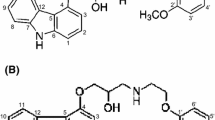Abstract
Purpose. To assess the role of intestinal CYP2D6 in oral first-pass drug clearance by comparing the enzyme content and catalytic activity of a prototype CYP2D6 substrate, metoprolol, between microsomes prepared from human intestinal mucosa and from human livers.
Methods. Microsomes were prepared from a panel of 31 human livers and 19 human intestinal jejunal mucosa. Microsomes were also obtained from the jejunum, duodenum and ileum of four other human intestines to assess regional distribution of intestinal CYP2D6. CYP2D6 content (pmole/mg microsomal protein) was determined by Western blot. CYP2D6 activity was measured by α-hydroxylation and O-demethylation of metoprolol.
Results. Kinetic studies with microsomes from select livers (n = 6) and jejunal mucosa (n = 5) yielded KM estimates of 26 ± 9 μM and 44 ± 17 μM, respectively. The mean Vmax (per mg protein) for total formation of α-OH-M and ODM was 14-fold higher for the liver microsomes compared to the jejunal microsomes. Comparisons across intestinal regions showed that CYP2D6 protein content and catalytic activity were in the order of jejunum > duodenum > ileum. Excluding the poor metabolizer genotype donors, CYP2D6 content varied 13-and 100-fold across the panels of human livers (n = 31) and jejunal mucosa (n = 19), respectively. Metoprolol α-hydroxylation activity and CYP2D6 content were highly correlated in the liver microsomes (r = 0.84, p < 0.001) and jejunal microsomes (r = 0.75, p < 0.05). Using the well-stirred model, the mean microsomal intrinsic clearance (i.e., Vmax/KM) for the livers and jejunum were scaled to predict their respective in vivo organ intrinsic clearance and first-pass extraction ratio. Hepatic and intestinal first-pass extractions of metoprolol were predicted to be 48% and 0.85%, respectively.
Conclusions. A much lower abundance and activity of CYP2D6 are present in human intestinal mucosa than in human liver. Intestinal mucosal metabolism contributes minimally to the first-pass effect of orally administered CYP2D6 substrates, unless they have exceptionally high microsomal intrinsic clearances and/or long residence time in the intestinal epithelium.
Similar content being viewed by others
REFERENCES
I. de Wazier, P. H. Cugnenc, C. S. Yang, J. P. Leroux, and P. H. Beaune. Cytochrome P450 isoenzymes, epoxide hydrolase and glutathione transferases in rat and human hepatic and extrahepatic tissues. J. Pharmacol. Exp. Ther. 253:387-394 (1990).
P. Du Souich, H. Maurice, and L. Héroux. Contribution of the small intestine to the first pass uptake and systemic clearance of propranolol in rabbits. Drug Metab. Dispos. 23:279-84 (1995).
T. Prueksaritanont, L. M. Dwyer, and A. E. Cribb. (+) Bufuralol 1′-hydroxylation activity in human and rhesus monkey intestine and liver. Biochem. Pharmacol. 50:1521-1525 (1995).
T. Prueksaritanont, L. M. Gorham, J. H. Hochman, L. O. Tran, and K. P. Vyas. Comparative studies of drug-metabolizing enzymes in dog, monkey, and human small intestines, and in caco-2 cells. Drug Metab. Dispos. 24:634-642 (1996).
Y. K. Tam. Individual variation in first-pass metabolism. Clin. Pharmacokin. 25:300-325 (1993).
T. Shimada, H. Yamazaki, M. Mimura, Y. Inui, and F. P. Guengerich. Interindividual variation in human liver cytochrome P450 enzymes involved in the oxidation of drugs, carcinogens and toxic chemicals: Studies with liver microsomes of 30 Japanese and 30 Caucasians. J. Pharmacol. Exp. Ther. 270:414-423 (1994).
M. F. Paine, M. Khalighi, J. M. Fisher, D. D. Shen, K. L. Kunze, C. L. Marsh, J. D. Perkins, and K. E. Thummel. Characterization of inter-and intra-intestinal differences in human CYP3A-dependent metabolism. J. Pharmacol. Exp. Ther. 283:1552-1562 (1997).
S. Snyder, M. J. Cook, E. S. Nasset, L. R. Karhausen, G. P. Howells, and I. H. Tipton. Report of the task group on reference man, Pergamon Press, Oxford, 1975, pp. 134-144.
O. H. Lowry, N. J. Rosebrough, A. L. Farr, and R. J. I. Randal. Protein measurement with the Folin phenol reagent. J. Biol. Chem. 193:265-275 (1951).
T. Omura and R. Sato. The carbon monoxide-binding pigment of liver microsomes. II. Solubilization, purification and properties. J. Biol. Chem. 239:2379-2385 (1964).
M. Kim, L. K. Roskos, D. D. Shen, A. C. Eddy, and W. L. Nelson. Inhibition of the enantioselective oxidative metabolism of metoprolol by verapamil in human liver microsomes. Drug Metab. Dispos. 21:309-317 (1992).
P. Klippert, P. Borm, and J. Noodhoek. Prediction of intestinal first-pass effect of phenacetin in the rat from enzyme kinetics data — Correlation with the in vivo data using mucosal blood flow. Biochem. Pharmacol. 31:2545-2548 (1988).
L. Hultén, J. Lindhagen, and O. Lundgren. Sympathetic nervous control of intramural blood flow in the feline and human intestines. Gastroenterology 72:41-48 (1977).
K. A. Johansson, L. Appelgren, K. O. Borg, and R. Elofsson. Binding of two beta-adrenoceptor antagonists, alprenolol and H93/26 to human serum proteins. Acta Pharm. Suec. 11:333-346 (1974).
H. Hoensch, C. H. Woo, S. B. Raffin, and R. Schmid. Oxidative metabolism of foreign compounds in rat small intestine. Cellular localization and dependency on dietary iron. Gastroenterology 70:1063-1070 (1976).
M. S. Lennard, G. T. Tucker, J. H. Silas, S. Freestone, L. E. Ramsay, and H. F. Woods. Differential stereoselective metabolism of metoprolol in extensive and poor debrisoquin metabolizers. Clin. Pharmacol. Ther. 34:732-737 (1983).
P. R. Gwilt, S. Comer, P. R. Chaturvedi, and D. H. Waters. The influence of diffusional barriers on presystemic gut elimination. Drug Metab. Dispos. 16:521-526 (1988).
V. J. Wacher, L. Salphati, and L. Z. Benet. Active secretion and enterocytic drug metabolism barriers to drug absorption. Adv. Drug Del. Rev. 20:99-112 (1996).
Author information
Authors and Affiliations
Corresponding author
Rights and permissions
About this article
Cite this article
Madani, S., Paine, M.F., Lewis, L. et al. Comparison of CYP2D6 Content and Metoprolol Oxidation Between Microsomes Isolated from Human Livers and Small Intestines. Pharm Res 16, 1199–1205 (1999). https://doi.org/10.1023/A:1018989211864
Issue Date:
DOI: https://doi.org/10.1023/A:1018989211864




